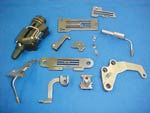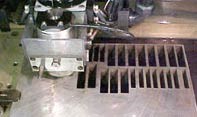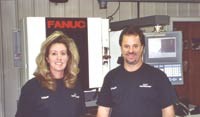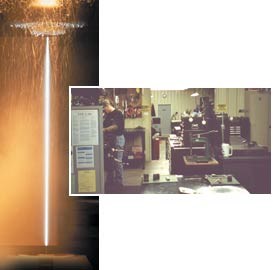Small Possibilities
These shop founders focused on what they knew rather than what they had heard about economic conditions when they established their business in October 2000. Their knowledge included the conviction that wire EDM could become the shop’s primary machining process.
Share




Takumi USA
Featured Content
View More
Hwacheon Machinery America, Inc.
Featured Content
View More
Autodesk, Inc.
Featured Content
View More


The conventional wisdom about recent economic conditions seems to warn against the launch of a new metalworking business. Given the number of machine shops that have been swept away by the recent downturn in manufacturing, making a decision to start from scratch might seem fraught with peril. A related obstacle is the difficulty of finding and training competent employees. And when the start-up shop is located in a rural area many miles away from major highways and cities, this challenge might seem insurmountable.
But Chuck Helm and Trina Lee focused on what they knew rather than what they had heard when they established C&T Technologies (Raywick, Kentucky) in October 2000. Their knowledge included the conviction that wire EDM could become the shop’s primary machining process.
The pitfalls and potential of this industry are second nature Mr. Helm and Ms. Lee, who are experienced metalworking professionals. During 17 years as a tool and die maker—and 6 years as a supervisor—Mr. Helm has observed the key roles that quality, promptness and personalized customer service play in building a successful business. Ms. Lee’s background includes a substantial amount of experience operating various CNC machine tools in the production of parts for air compressors, natural gas meters and regulators.
With many years of experience using wire EDM, Mr. Helm was aware of the great potential to leverage today’s improved technology in the context of a small, flexible operation. Equipped only with manually operated machine tools and a 1984-vintage wire EDM machine when it opened for business in the autumn of 2000, C&T initially had a very limited production capacity. For this reason, Mr. Helm and Ms. Lee often had to rely on other machine shops to handle their EDM work. This was an inconvenient and costly arrangement, particularly in view of the shop’s location.
Realizing that the wire EDM work represented a production bottleneck, they investigated various types of new machines. After considerable analysis, they purchased a Fanuc Robocut iB Series machine in July 2002 from Methods Machine Tools Inc. Given Mr. Helm’s substantial EDM experience and the expertise of the setup technician from Methods, the shop began running parts after only a 1-day installation and tutorial. As anticipated, the new machine has substantially improved their shop’s productivity. Furthermore, it has enabled Mr. Helm and Ms. Lee to alter the conventional role of EDM in the overall machining process.
Small Advantages
C&T’s early growth reflects the fact that promising niches are continually being created in many areas of the country for small shops that offer high flexibility and excellent service. In many regions, these lucrative gaps emerge when customers’ needs diverge from the capabilities of high-volume job shops. When a customer needs a relatively small number of parts manufactured—particularly if fast or immediate delivery is required—high-volume shops usually can’t disrupt their operations to meet this demand.
Mr. Helm and Ms. Lee have positioned their shop to exploit this important niche by specializing in short runs, prototypes and some reverse-engineered parts. For example, the shop produces critical components for various types of production machinery used by manufacturers in the central Kentucky region. “We’ve taken advantage of lower overhead costs and our ability to respond rapidly to customers’ needs,” says Mr. Helm. At present, approximately 75 percent of the shop’s business is connected with the automotive industry.
To build business, C&T has gradually expanded its reputation among regional manufacturers as a store for various specialty parts that are needed periodically. Mr. Helm believes that this supplier relationship is extremely important for a small machine shop to cultivate. For this reason, C&T makes a substantial investment to maintain an adequate stock of parts to meet its customers’ needs. Under normal circumstances, the shop can ship parts immediately when regular customers call. In emergency situations, such as when a production line is shut down because of a broken part, C&T provides immediate or same-day delivery at no additional charge to the customer.
Because its customers don’t pay for parts until they take delivery, C&T carries the cost to maintain this inventory. Occasionally, when specific parts are no longer needed because a customer’s equipment has been replaced, the shop absorbs the full cost of some obsolete parts in its inventory. But taking this risk is necessary to enable C&T to provide the level of customer service that helps build its reputation in Kentucky and beyond.
An important aspect of the shop’s flexibility is the ability to squeeze additional EDM time out of what might seem to be a full production schedule. Thus, the faster programming and operation possible with the new Fanuc machine not only enable the shop to accept more work overall, but also to accept a larger number of rush jobs. “If necessary, we can have a customer’s job running on our wire EDM machine within 2 hours,” says Mr. Helm.
C&T also carefully manages its inventory of metals to avoid production delays arising from depletion of stock. At any given time, therefore, the shop maintains a sufficient reserve stock of each type of metal that its customers commonly use. This enables prompt handling of customer needs that Mr. Helm and Ms. Lee estimate by reviewing records of the customer’s previous orders. Although inventory management is important for machine shops regardless of size, shops located closer to suppliers may perhaps be less methodical with regard to supply issues. Given its isolated location, however, this factor is crucial for C&T.
To further manage supply issues, C&T also builds all necessary fixturing in house and maintains its own heat-treatment equipment. In addition to the new wire EDM machine, the shop is also equipped with a Haas Mini-Mill, a Haas SL10 turning center, a surface grinder, a manual-type lathe and manual milling machines. Although they do not currently own a CMM, Mr. Helm and Ms. Lee are able to perform certain reverse engineering tasks by using the Fanuc wire EDM machine to reference the dimensions of existing parts.
Reversing The Process
Because of its small size and short-run production, C&T is able to use wire EDM in a way that larger shops might deem impractical. Mr. Helm’s term for this process is “backwards EDM,” meaning that EDM has been switched from a secondary operation to the shop’s primary machining process. When he was a machine shop employee, Mr. Helm frequently saw parts being run on milling machines that might have been produced faster and more accurately via wire EDM. In the production environment of this large job shop, however, company rules did not allow for the strategy that C&T now uses. Indeed, many shops dedicate EDM entirely to secondary operations. But given the significantly faster cutting speeds available on today’s machines, the stereotype of EDM as a ponderous operation is no longer valid.
C&T now uses only this single Fanuc machine to complete nearly all of its EDM work. The machine’s cutting speed and processing advantages have enabled wire EDM to become the shop’s primary machining process. And the impact on the shop’s efficiency has been significant. “Compared to our previous process, we’re now running half of our jobs about 50 percent faster,” says Mr. Helm. For certain parts, the time savings have been even more impressive. “We reduced the time to complete one part from 41 hours to only 16 hours, while the time for a different part was cut from 3.5 to 1.2 hours,” he says.
In addition to faster cutting speeds, the new machine incorporates two key features that enable C&T to further reduce its overall machining time. First, the Fanuc Auto Wire Feed System eliminates interventions by operators to correct wire breakage or threading problems. “This is the simplest yet most advanced threading system that I’ve seen,” says Mr. Helm. “Not only can it thread through a start hole, but it also can thread through the kerf of a fully submerged workpiece of maximum thickness for the machine’s capacity.”
This feature allows the wire to be threaded through various parts without retracing the cutting path. An integral pecking function automatically retries threading until the precise hole location is found. Because the system threads wire directly through submerged workpieces, the need to drain and refill the tank for each rethreading is eliminated. Additionally, the machine can be programmed to shut down and notify the operator before the entire spool of wire is expended.
The second feature is the Fanuc 180is-WB CNC. This control incorporates artificial intelligence that enables the operator to create a part program via a screen-prompted, conversational process and without the need for operator calculations. The CNC’s functions include automatic creation of program formats, monitoring/control of cutting conditions and accurate estimating of the total cutting time required to machine a specific part.
“Because of the small amount of information required to generate power settings, a job can be running in a matter of minutes after loading the program,” says Mr. Helm. The required information includes only the program number, workpiece thickness, desired finish and tolerance. C&T uses BobCAD-CAM and AutoCAD 2000 to generate CNC code, and the CNC’s options for downloading include RS 232, a 3.5-inch floppy disk drive, Flash card and Ethernet.
Traditional Training And Modern Challenges
Besides the owners, the shop has three employees plus a fourth employee who makes pick-ups and deliveries. Like metalworkers of previous generations, C&T’s employees have developed their skills from the ground up under the tutelage of experienced metalworkers. Mr. Helm and Ms. Lee conduct in-house training that has already succeeded in making their employees self-sufficient.
After retiring from a 33-year career on the bottling line at the Jim Beam Brands distillery, full-time employee Dorothy Mattingly has worked for the shop since it opened for business. Corey Thompson, who has worked for only about 6 months with C&T, got a head start on his career by previously studying machine tool technology at a local technical college. Part-time employee Robbie Mattingly has 3 years of prior machine shop experience.
Given C&T’s rural location and modest size, it’s interesting to note that this shop is currently involved in the development of a new automotive technology. C&T machines prototype parts for a company that is developing an innovative type of rotary engine. Although this shop is only about the size of a large garage, the work that it produces is a reminder that many of America’s best-known businesses sprouted from similarly humble roots. Furthermore, C&T’s early success demonstrates that fertile ground can still be found in the metalworking industry for sowing entrepreneurial seeds.
Read Next
EDM For The Long Run
To manufacture large quantities of similar parts, a Georgia machine shop has found that wire EDM is the ideal process.
Read MoreRegistration Now Open for the Precision Machining Technology Show (PMTS) 2025
The precision machining industry’s premier event returns to Cleveland, OH, April 1-3.
Read MoreBuilding Out a Foundation for Student Machinists
Autodesk and Haas have teamed up to produce an introductory course for students that covers the basics of CAD, CAM and CNC while providing them with a portfolio part.
Read More












































.jpg;maxWidth=300;quality=90)







